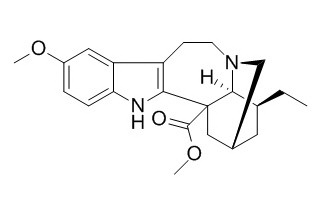Voacangine
Voacangine is a novel transient receptor potential vanilloid type 1 (TRPV1) antagonist, it shows mod. cytotoxic activity, also some CNS, brachycardial and hypotensive action.Voacangine significantly suppresses in vitro angiogenesis, such as VEGF-induced tube formation and chemoinvasion.
Inquire / Order:
manager@chemfaces.com
Technical Inquiries:
service@chemfaces.com
Tel:
+86-27-84237783
Fax:
+86-27-84254680
Address:
1 Building, No. 83, CheCheng Rd., Wuhan Economic and Technological Development Zone, Wuhan, Hubei 430056, PRC
Providing storage is as stated on the product vial and the vial is kept tightly sealed, the product can be stored for up to
24 months(2-8C).
Wherever possible, you should prepare and use solutions on the same day. However, if you need to make up stock solutions in advance, we recommend that you store the solution as aliquots in tightly sealed vials at -20C. Generally, these will be useable for up to two weeks. Before use, and prior to opening the vial we recommend that you allow your product to equilibrate to room temperature for at least 1 hour.
Need more advice on solubility, usage and handling? Please email to: service@chemfaces.com
The packaging of the product may have turned upside down during transportation, resulting in the natural compounds adhering to the neck or cap of the vial. take the vial out of its packaging and gently shake to let the compounds fall to the bottom of the vial. for liquid products, centrifuge at 200-500 RPM to gather the liquid at the bottom of the vial. try to avoid loss or contamination during handling.
mBio.2020, 11(3):e00686-20.
Nat Commun.2021, 12(1):681.
Biochemical Systematics and Ecology2018, 81
Molecules.2023, 28(4):1526.
Mol Cells.2018, 41(8):771-780
Plant Physiol Biochem.2023, 202:107913.
OENO One2023, 57:3.
Biochem Biophys Res Commun.2020, 522(4):1052-1058
Nutrients.2021, 13(10):3414.
J of Ana. Chem.2019, 74(11):1113-1121
Related and Featured Products
Biochem Biophys Res Commun. 2012 Jan 6;417(1):330-4.
A natural small molecule voacangine inhibits angiogenesis both in vitro and in vivo.[Pubmed:
22155252]
Angiogenesis, the formation of new blood vessels from pre-existing ones, plays a critical role in normal and pathological phenotypes, including solid tumor growth and metastasis.
Accordingly, the development of new anti-angiogenic agents is considered an efficient strategy for the treatment of cancer and other human diseases linked with angiogenesis.
METHODS AND RESULTS:
We have identified Voacangine, isolated from Voacanga africana, as a novel anti-angiogenic agent. Voacangine inhibits the proliferation of HUVECs at an IC(50) of 18 μM with no cytotoxic effects. Voacangine significantly suppressed in vitro angiogenesis, such as VEGF-induced tube formation and chemoinvasion. Moreover, the compound inhibits in vivo angiogenesis in the chorioallantoic membrane at non-toxic doses. In addition, Voacangine decreased the expression levels of hypoxia inducible factor-1α and its target gene, VEGF, in a dose-dependent manner.
CONCLUSIONS:
Taken together, these results suggest that the naturally occurring compound, Voacangine, is a novel anti-angiogenic compound.
J Nat Prod. 2014 Feb 28;77(2):285-97.
Activation and inhibition of thermosensitive TRP channels by voacangine, an alkaloid present in Voacanga africana, an African tree.[Pubmed:
24484240]
Voacangine (1) is an alkaloid found in the root bark of Voacanga africana.
Our previous work has suggested that 1 is a novel transient receptor potential vanilloid type 1 (TRPV1) antagonist.
METHODS AND RESULTS:
In this study, the agonist and antagonist activities of 1 were examined against thermosensitive TRP channels. Channel activity was evaluated mainly using TRP channel-expressing HEK cells and calcium imaging. Herein, it was shown that 1 acts as an antagonist for TRPV1 and TRPM8 but as an agonist for TRPA1 (EC50, 8 μM). The compound competitively blocked capsaicin binding to TRPV1 (IC50, 50 μM). Voacangine (1) competitively inhibited the binding of menthol to TRPM8 (IC50, 9 μM), but it showed noncompetitive inhibition against icilin (IC50, 7 μM). Moreover, the compound selectively abrogated chemical agonist-induced TRPM8 activation and did not affect cold-induced activation.
CONCLUSIONS:
Among these effects, the TRPM8 inhibition profile is unique and noteworthy, because to date no studies have reported a menthol competitive inhibitor of TRPM8 derived from a natural source. Furthermore, this is the first report of a stimulus-selective TRPM8 antagonist. Accordingly, 1 may contribute to the development of a novel class of stimulus-selective TRPM8 blockers.



